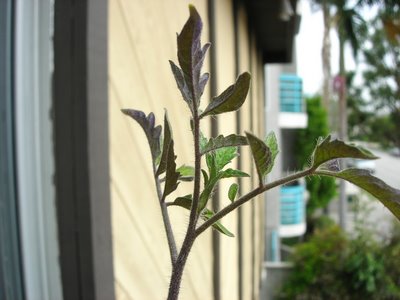I think it's a common conception that growing your own food saves money. After all, you can get 30-50 seeds for $2-4 and grow 30-50 edible items from that. That's practically free food, right?
First, you need to factor in the cost of gardening supplies. For a small container garden like the one you see here, the costs are as follows:
| garden spade | $4 |
| fertilizer | 6 |
| organic insecticide | 6 |
| 4 bags of dirt | 32 |
| 3 bags of Perlite | 24 |
| 9 large containers | 0-90 |
| 20 small containers | 0-10 |
| 12 packets of seeds | 0-40 |
| watering can | 0-10 |
In my case, the total cost of my container garden so far has been $170, and it has produced lots of basil, about 30 peas, nine cherry tomatoes, and one zebra tomato. You don't have to be a math genius to realize that my container garden has been a money pit. However, a lot of the costs are start-up costs, and if my garden is more successful in the future, I might get closer to breaking even. There are many ways to reduce your container garden costs, however, and I wasn't aware of all of them when I started out. Here are some important money saving tips:
Fertilizer and insecticide: not essential. In fact, these haven't helped me at all. I wouldn't buy them again.
Dirt: wait for a good sale and buy a bunch. Shop around to see if a small local nursery or a large chain has the better prices.
Perlite: Same goes for Perlite, though I'm not sure it's necessary.
Containers: Especially if you live in an apartment complex, keep an eye on the alley. Where I live, people throw out flower pots and large plastic containers all the time (you'll need to drill drainage holes in the containers, but that's easy. If you don't have a drill, borrow one). Also ask friends for containers and hit thrift shops. If you can't scrounge up everything you need with these methods, most nurseries will sell you cheap black buckets. There's no need to spend $10 and up more per container unless you're really concerned with aesthetics. I can't believe how much these new containers cost!
Small containers: These shouldn't cost much, but they can be free if you save yogurt cups and use those. Don't forget to poke holes in the bottom for drainage.
Seeds: You can save money on seeds by saving seeds. This doesn't always give you useable seeds though, so you'll need to do some research if you want to go this route.
Watering can: This one is easy. Just save a plastic milk jug and use that. If you don't drink milk, buy something else that comes in a jug and when the liquid is gone, you'll have your free watering can.

























